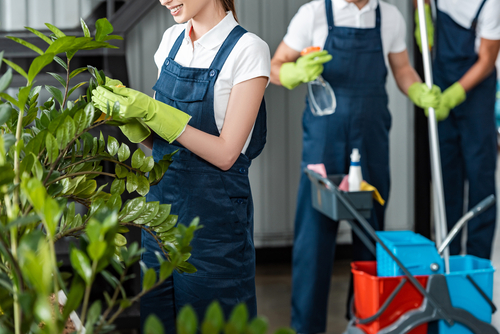Plants require proper care and maintenance to thrive and cleaning is an essential part of the routine, but it’s important to approach it with caution and knowledge. Unfortunately, many plant owners make some common mistakes that can harm their beloved green companions. Understanding these mistakes is crucial in order to avoid potential damage and promote the health of your plants.
Hiring a dependable maid service in Greer that covers this type of tasks can help you take proper care of your plants. However, being aware of potential mistakes can help you become a more informed and effective plant caregiver. By recognizing and rectifying these errors, you can ensure that your plants flourish in a clean and nurturing environment. Let’s explore these common plant cleaning mistakes and learn how to avoid them.
What mistakes do people make when cleaning plants?
Removing dust and cleaning plants is an important aspect of their care, but it’s essential to approach it properly as they are living organisms that require specific care and attention. Here are some common mistakes and tips on how to avoid them:
Overcleaning
One of the most common mistakes is overcleaning plants. While it’s important to keep them tidy, excessive cleaning can be detrimental. They have a natural protective layer on their leaves, known as the cuticle, which helps them retain moisture and protect against pests.
Excessive wiping or scrubbing can remove this protective layer, making plants more susceptible to water loss and damage. You can avoid this by limiting this task to when it’s necessary, such as removing dust or debris.
Using harsh agents
Using harsh chemicals can cause harm. Many household products contain chemicals that can be toxic to plants. Avoid using these products on or near your plants. Instead, opt for natural alternatives such as mild liquid soap or a mixture of water and vinegar. Dilute the solution and test it on a small area of the plant before applying it more broadly.
Cleaning during the wrong time
Timing is important as well. Avoid cleaning them during the hottest part of the day or when they’re under direct sunlight. Water droplets on leaves can act as magnifying glasses, intensifying the sunlight and potentially causing burns or damage to the foliage. You can do it in the early morning or late afternoon when the sun is less intense to minimize the risk of harm.
Neglecting to inspect for pests
Failing to inspect your plants for pests and insects can allow infestations to go unnoticed and spread. Carefully examine the leaves, stems, and soil for any signs of pests, such as webs, insects, or chewed foliage. If you identify any of those, take appropriate measures to treat the infestation and prevent further damage.
Using dirty tools
Tools such as cloths or brushes can harbor dirt, dust, or pests. Reusing them can introduce contaminants to your plants and potentially spread pests or diseases. Always use clean and dedicated tools for each plant or wash them thoroughly between uses. Wash cloths, sponges, or brushes with mild soap and water, rinse them well, and allow them to dry before using them on another plant.
Neglecting to support delicate plants
Some plants have delicate or sensitive foliage that can be easily damaged during the process. Examples include plants with fine hairs, intricate leaf patterns, or plants with velvety surfaces.
When taking care of them, use gentle techniques such as lightly brushing away dust with a soft brush or using a can of compressed air to remove debris. Avoid rough handling or aggressive methods that could harm the delicate foliage.
Not adjusting methods for different plant types
Different plants have different cleaning requirements. Some plants, such as succulents or cacti, have waxy leaves that should not be sprayed or wiped with water. Instead, use a soft brush or a can of compressed air to remove dust. Research and understand the specific needs of each plant in your collection to ensure you’re using the appropriate methods and avoiding potential damage.
Neglecting the underside of leaves
It’s easy to focus on the upper surfaces of leaves and neglect the undersides. However, the undersides can also accumulate dust, pests, or fungal spores. Take the time to gently lift the leaves and wipe them using a soft cloth or brush. This will help prevent pest infestations and ensure that your plants are thoroughly taken care of.
Watering immediately after cleaning
This can lead to moisture-related issues such as root rot or fungal diseases. Give your plants some time to dry before watering them. Allow them to sit in a well-ventilated area until the foliage is completely dry. Once dry, resume your regular watering routine.
Failing to observe plant reactions
Each plant is unique and may respond differently to different methods. Observe them after you’ve completed the process to ensure they’re responding positively. If you notice any negative effects, such as leaf discoloration or wilting, adjust your techniques or frequency accordingly. Pay attention to the signals your plants give you and tailor your approach to meet their individual needs.
Where can I find dependable maid service in Greer?
When you’re not sure how to get ready to clean your plants or you need assistance with other household chores, reach out to Castle Keepers. Our meticulous and dedicated experts go above and beyond to meet your needs and secure a hygienic and safe environment for you and your family. Whether you home’s in Greer or anywhere else across the region, you can count on us. Get in touch with us today!






